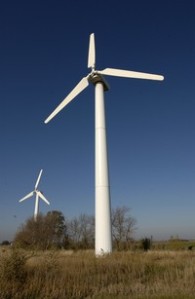The city of Howard, SD is featured in the August issue of Western Area Power Administration’s Energy Services Bulletin. According to the editor, Howard’s profile is the first of an ongoing series of customer profiles, highlighting the strengths, challenges, programs and operational and planning strategies WAPA customers use to keep the lights on. The article describes Howard as a community defined not by its size or challenges, but by its can-do spirit, and discusses the city’s integrated resource plan and energy efficiency options as well as its economic successes and hardships.
Energy Services Bulletin is WAPA’s monthly energy efficiency and planning newsletter dedicated to customer activities and sharing information. The goal of the customer profile series is to “encourage utilities to recognize the issues they have in common an to swap ideas and ask each other questions.” If you would like your utility to be featured, email storie@wapa.gov.
Vision for future, action today set Howard, SD, apart
Howard, SD, population 858, is defined not by its size or challenges, but by its can-do spirit.
The small municipal utility that serves the eastern South Dakota city is a Western customer and member system of Heartland Consumers Power District. A characteristically bare-bones staff attends to 500 residential, 130 commercial and three industrial meters. City Finance Manager Donna Klinkhammer, handles billing and fields customer calls while Electric Superintendent Kody Dawson manages the operational side, with an occasional assist from Water Foreman Jerry Adler. In other words, Howard looks like most small-town power providers—until you start digging into the details.
Wind pioneer
Take those two wind turbines at the western edge of town, for example. Howard was the first municipality in South Dakota to own and operate its own wind turbines. Installed in 2001, the reconditioned 108-kilowatt (kW) Micon units supply almost 10 percent of the city’s energy needs.

These two 108-kw Micon turbines were the first municipally owned and operated wind generators in the state of South Dakota. Courtesy Howard, SD.
The percentage of wind in Howard’s power portfolio is higher than the nation’s, which hovers around 3 percent, but the fringe benefits to the city are even greater. The wind project persuaded Broadwind Energy LLC to locate a gearbox maintenance and testing facility in the town, bringing 35 jobs for city residents. “Those turbines have been really good for economic development,” confirmed Klinkhammer.
Broadwind represents the utility’s biggest load, she noted. “Demand really spikes when they are testing the gearboxes,” Klinkhammer said. “We just put in a new transformer at the plant to handle it.”
Economic success story
The utility is also making a $40,000 addition to its system to serve an elevator and fertilizer plant that are part of the Howard Farmers’ Cooperative complex. PBM Packaging, a commercial printing service with 24-hour operations rounds out Howard’s roster of commercial and industrial customers. “Our biggest operational challenge is making sure our infrastructure can keep up with the economic growth,” said Klinkhammer.
That’s a great problem for a small, rural city to have, and some of the credit goes to Miner County Community Revitalization (MCCR). The nonprofit organization grew out of a high school class project in which the students studied the causes of the area’s decline and identified solutions. The project brought the community together and led to the establishment of MCCR in 1997.
The Northwest Area Foundation launched a 10-year exploratory partnership with MCCR in 2001 to look for ways to bring sustainable business development to Howard. MCCR purchased one of the wind turbines and donated it to the city, helped to attract an organic beef producer to the area and built a conference center and hotel for wind technician training. As a result of these efforts, Howard enjoys a much stronger economy than is the norm for rural America.
Hard times anyway
Unfortunately, nothing is recession proof, and Howard felt the effects the economic downturn. The beef company relocated to Oregon in 2010, and another company took over the facility for storage only. That same year, the uncertain future of the production tax credit caused the wind industry to slump, and Broadwind temporarily laid off a third of its workforce. The slump may have been partly responsible for the closure of the conference center and hotel last year. “The industry didn’t need workers, so there was less need for training,” Klinkhammer pointed out.
As Howard slowly emerges from the recession along with the rest of the country, the utility’s load appears not to have suffered any permanent contraction. Klinkhammer noted that growing load is still not as high a priority as infrastructure projects like burying overhead power lines.
Cost consciousness counts
Planning, too, takes a back seat to meeting the day-to-day power needs of residents. Like many small municipalities, Howard City Utilities submits its integrated resource plan through its power wholesaler, Heartland. “We provide them with our information and they do the projections,” said Dawson.
Heartland also provides energy-efficiency options for Howard. Residents can get a high-efficiency Marathon water heater at half the city’s cost through Heartland and participate in their load control program. “They appreciate the opportunity to manage their energy costs,” Dawson acknowledged.
Like its residents, Howard, S.D., likes to control its energy costs, too. Hydropower from Western helps keep the city’s electricity rates affordable, said Klinkhammer. In small towns on the prairie, even ones with big visions, like Howard, every little bit helps.
Resources
Howard, S.D.
Howard City Utilities
Heartland Consumers Power District
Broadwind Energy LLC
Howard Farmers’ Co-op
Miner County Community Revitalization
Integrated resource plan
People
Energy Services Bulletin Editor
Donna Klinkhammer
